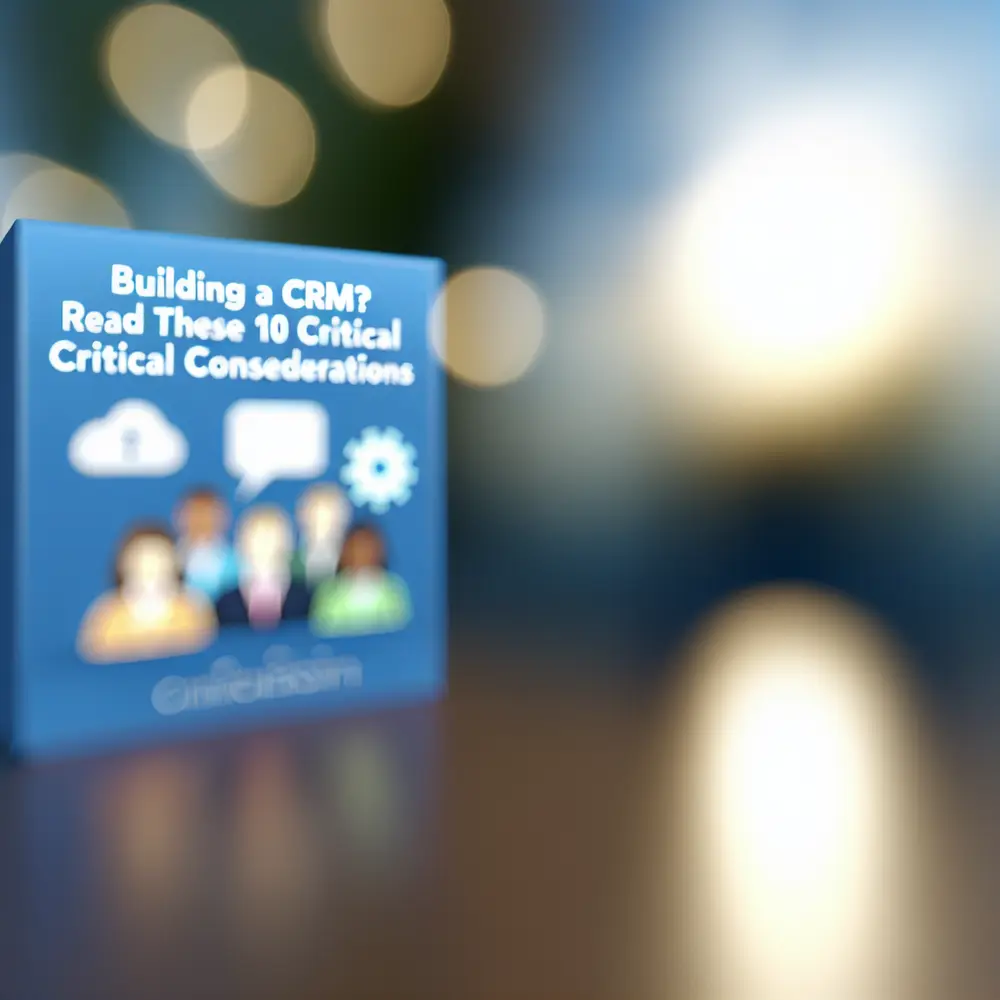Understanding the Importance of Building a CRM
Are you aware that building a CRM is not just a technical task? It’s a strategic imperative that directly influences your customer relationships and business outcomes. Effectively developing a CRM aligns with your organization’s broader business strategy. This ensures that customer interactions are streamlined and meaningful.
Consider how the right approach can enhance customer satisfaction and increase your sales. For instance, a company called Clínica Simples implemented a CRM tailored to their specific needs. They witnessed a 25% increase in patient retention rates in just six months.
The software selection process is the most critical step in building a CRM. Evaluate various CRM solutions and weigh their features against your organizational needs to make an informed choice. A well-chosen CRM not only offers vital tracking and data management features but also enhances team collaboration.
Moreover, the customization capacity within your selected software can significantly impact its effectiveness in addressing your unique demands. A study found that businesses that customize their CRM systems see an average sales increase of 20% (Gartner Research – https://www.gartner.com/en/insights/customer-experience).
In addition to technical features, ensure your business strategy is at the heart of your CRM considerations. By aligning CRM development with your objectives, you will harness customer data to drive strategic decisions, tailoring marketing and sales strategies effectively.
CRM Integration: Enhancing Customer Engagement
The integration capabilities of your CRM system are vital for its effectiveness. A flexible framework allows seamless connections with existing tools and platforms, such as marketing automation and communication channels. For example, Transportadora Prime implemented a CRM that integrated with WhatsApp, resulting in real-time interactions that improved customer response times by 30%.
In summary, meticulously plan your CRM building process, from software selection to aligning it with your business strategy. By prioritizing these aspects, you enhance customer engagement and drive growth. Consider the benefits of a CRM integrated with WhatsApp for small businesses to further amplify your engagement strategies.
Defining Your Requirements: The Foundation of Successful CRM Development
Defining your CRM requirements is crucial as it lays the groundwork for successful development. Engage various stakeholders, including sales and marketing teams, to gather comprehensive input on system needs. This approach ensures the CRM addresses all aspects of your operations.
For example, Loja Verde conducted an assessment of current workflows and identified gaps during their CRM selection. By documenting specific needs, they compared solutions effectively, leading to a 15% boost in team efficiency.
Focus on functionalities that enhance communication and streamline processes, and don’t overlook scalability. A CRM should adapt as your business grows. Prioritize features that allow easy upgrades, ensuring long-term relevance.
Consider integration capabilities; a CRM that connects seamlessly with existing tools improves data accessibility and decision-making. Businesses that utilize integrated systems have reported up to a 25% reduction in time spent on data entry, according to reports from the Project Management Institute (PMI – https://www.pmi.org/learning/library/project-management-automation-information-technology-12245).
Usability is another critical factor. A user-friendly interface promotes adoption and minimizes training time. Involving potential users in the selection process increases satisfaction and efficiency.
Choosing the Right Technology Stack for Your CRM
When building a CRM, selecting the appropriate technology stack is paramount. The right stack ensures scalability, flexibility, and integration capabilities. Assess your current infrastructure and future needs carefully. For instance, Tech Innovations adopted a modern stack that improved their CRM’s performance, leading to a 30% increase in user engagement.
Evaluate both front-end and back-end technologies; popular frameworks like React and Angular offer dynamic interfaces. Additionally, suitable database choices, such as PostgreSQL or MongoDB, significantly influence data management efficiency.
Integration capabilities should not be overlooked. Your CRM must connect with existing tools like marketing and analytics platforms. Tools like Zapier can facilitate this integration, aligning your tech stack with necessary APIs. For details, check our guide on how to create an Automated Service Menu on WhatsApp.
Moreover, prioritize security measures in your technology selection. Given the sensitive nature of customer data stored in your CRM, adhere to industry standards, such as strong encryption and two-factor authentication.
Finally, consider vendor support and community involvement around your tech stack. Active communities provide valuable resources, enhancing your CRM development process.
Integration Capabilities: Ensuring Seamless Workflow
One of the foremost considerations when building a CRM is its integration capabilities. Many businesses rely on multiple software solutions for operations. Therefore, choosing a CRM that integrates seamlessly with existing applications is essential for coherent data flow and operational efficiency.
A robust CRM development strategy includes evaluating potential integration points. Ensure your chosen CRM has pre-built integrations with tools your business already employs. Custom integration options can also enhance overall utility.
Furthermore, the ease of integrating third-party applications significantly impacts user adoption rates. A CRM that allows easy integrations fosters a better user experience and platform engagement.
Data synchronization capabilities also play a critical role. Real-time updates enable various departments to access the latest information, positively impacting collaboration and decision-making.
As your business evolves, scalability in integration features becomes crucial. Opt for a CRM adaptable to new tools without extensive reconfiguration, ensuring sustained relevance.
User Experience Design: Prioritizing Usability in Your CRM
User experience (UX) design should be at the forefront of CRM development. A seamless interface influences user adoption and efficiency. Investing in UX design correlates with higher satisfaction rates among teams.
For example, Consultoria Alfa focused on UX during their CRM development, leading to a 40% reduction in training time for employees. They concentrated on user-friendly designs that facilitated easy navigation.
When selecting CRM software, look for features that enhance user interaction, such as customizable dashboards and mobile accessibility. Ensuring good integration with existing systems minimizes disruption and promotes cohesion.
Engage end-users during the design process to uncover pain points. This participatory approach fosters a user-friendly environment that aligns the CRM with overall business strategy.
Prioritizing usability is an ongoing process. Regularly revisiting user experience will promote adaptability to technological advancements, ultimately enhancing operational growth.
Data Security and Compliance: Protecting Business and Customer Information
Building a CRM that prioritizes data security and compliance is essential. With data breaches on the rise, integrating robust security measures within your CRM is crucial. Implement encryption, access controls, and perform regular audits to safeguard data integrity.
When selecting software, ensure adherence to industry regulations like GDPR and CCPA. Non-compliance incurs financial penalties and damages reputation. A trusted CRM like the one provided by Soluções Digitais ensures compliance features are included, protecting sensitive data.
Establish a business strategy around data management, defining retention policies and training programs. Regular updates and patches maintain software security, protecting against potential threats.
Assess the implications of cloud-based versus on-premise solutions. Evaluate security certifications and incident response plans of vendors to ensure robust protection of your data.
Focusing on data security throughout CRM development effectively preserves critical information and maintains customer trust, aligning with regulatory adherence.
Scalability: Building a CRM That Grows with Your Business
Scalability is a crucial factor in CRM development. Your system should adapt to accommodate increasing data volume and user accounts without compromising performance. The right solutions should offer modular features for future enhancements.
Smart Logistics adopted a cloud-based CRM that enhanced their scalability, resulting in a 20% improvement in operational efficiency as their user base grew. Their investment in modular technology allowed seamless additions as their business expanded.
Ensure your CRM supports integration with other systems for cohesive data management. A well-structured database can substantially enhance operational efficiency as your business grows.
Align your CRM’s capabilities with your long-term business strategy. A flexible CRM that adapts to market changes can streamline processes for your evolving team.
Finally, continuous assessment is essential post-deployment. Evaluate your CRM’s scalability metrics and establish feedback loops to identify growth bottlenecks.
Custom vs. Off-the-Shelf Solutions: Which is Right for You?
Choosing between custom and off-the-shelf CRM solutions is a critical decision. Custom development offers a tailored approach that meets specific needs, while off-the-shelf options provide quicker deployment at lower initial costs.
Agência Criativa opted for a custom CRM built to their specifications, resulting in a 33% increase in project delivery speed. Their tailored solution allowed adaptability to their unique workflows.
Off-the-shelf solutions are often easier to use and regularly updated by vendors. For organizations seeking immediate implementation without extensive customization, these may be ideal.
However, consider long-term scalability. Custom solutions can evolve with your business, whereas off-the-shelf systems may require additional purchases for growth, potentially increasing cumulative costs.
Finally, reflect on your business strategy. If unique functionalities are necessary, a custom CRM is likely the better choice. Conversely, if you need a standard solution quickly, opt for off-the-shelf options.
Budgeting and Resources: Planning for Successful CRM Development
Effective budgeting is crucial for successful CRM development. Assessing both financial and human resources ensures you allocate sufficient funds for software development, implementation, maintenance, and training.
For example, Serviços Financeiros leveraged a budget-efficient approach, integrating a CRM for WhatsApp that enhanced productivity without exceeding costs. This thoughtful planning resulted in a 20% increase in service efficiency.
Consider long-term maintenance costs as well; many business owners underestimate expenses associated with CRM upkeep. Project these costs over several years to prevent future financial shocks.
Integrating feedback loops into your budgeting process improves resource allocation. Regularly review progress against objectives for alignment with CRM development and business strategy.
This strategic focus leads to a robust CRM infrastructure that delivers long-term value.
Implementing and Evaluating CRM Success: Metrics That Matter
The implementation phase of your CRM is critical for achieving business goals. Evaluating success requires an understanding of key performance metrics. Focus on specific criteria to ensure your CRM aligns with your business strategy.
One essential metric is user adoption rate. High adoption indicates an intuitive CRM. Feedback from team members is crucial for identifying areas needing improvement.
Customer satisfaction is another vital metric. A CRM should enhance communication, improving the service experience. Regular assessments of feedback, NPS, and retention rates reveal how effectively your CRM meets customer needs.
Data accuracy is also crucial. Inaccurate data can mislead decisions. Implement audits and validation checks to maintain integrity, alongside automated processes for efficiency.
Sales performance metrics are particularly relevant. Track conversion rates and sales cycles to determine if the CRM supports effective sales strategies. Evaluating integration capabilities helps gauge overall effectiveness.
Conclusion: Making Informed Decisions in CRM Development
Building a CRM necessitates meticulous planning and strategic foresight. Consider how the CRM aligns with your overall business strategy, and identify the specific needs of your organization.
Evaluate software selection carefully; not all CRM solutions are created equal. Features such as user interface, scalability, and integration capabilities are crucial for supporting business processes.
Engaging stakeholders throughout the development fosters collaboration. IT directors play an essential role in assessing potential software options, bridging technical specifications and business needs.
Lastly, consider future scalability to ensure the CRM adapts to evolving demands. Integration with tools like CRM for WhatsApp enhances customer engagement and drives value.
Prioritizing these areas lays the foundation for a successful CRM that grows with your business, maximizing your investment and enhancing customer satisfaction.









